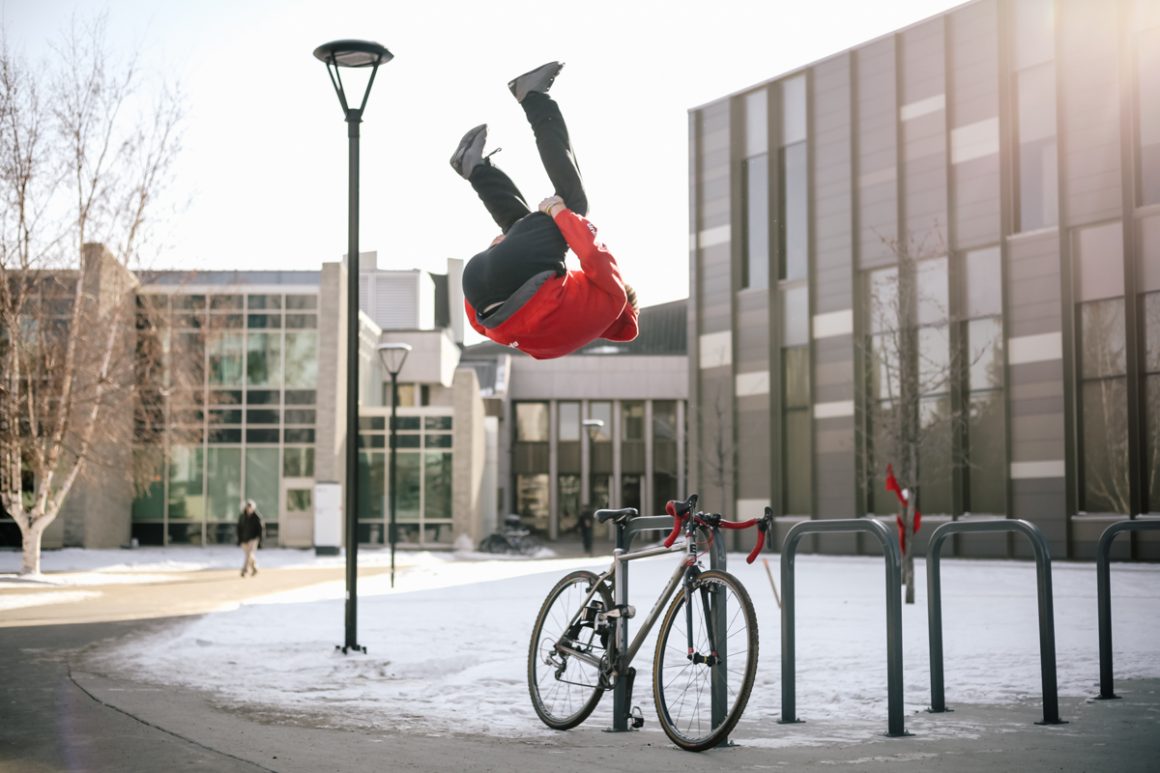
Calgary athlete keeps parkour spirit alive
By David Song, February 7 2019 —
As a sport, parkour is often misunderstood. The very word calls to mind brave daredevils executing flamboyant tricks in urban environments, wearing no safety equipment whatsoever. In the minds of many, parkour is synonymous with flashy, gymnastics-like techniques such as flips and twists.
It is a misconception that many parkour athletes — known in the sport as traceurs — would like to dispel, including Calgary’s Zach McIver. Born and raised in Kingston, Ontario, McIver has been training in the sport for a decade and coaching for about half that time. As he explains, parkour is about far more than just fancy tricks.
“The beauty of parkour is that there’s no one definition that fully encapsulates what it is,” McIver said. “I like to [think of it as] the art of overcoming obstacles using only the human body, or basically to sum that up: running, jumping and climbing. It can look very different depending on the person practising it.”
In fact, the branch of parkour that emphasizes flashy techniques represents only one portion of the overall discipline. In official tournaments like the North American Parkour Championships (NAPC), this type is known as style and exists alongside two other subtypes. The others are speed, which emphasizes moving from point A to point B as efficiently as possible, and skill, which involves tackling a variety of challenges designed to test the traceur’s agility, balance and overall fitness level.
McIver’s parkour journey began at age 12, when his father read about the sport in a newspaper. He recalls falling in love with parkour almost immediately and getting his friends to join him as soon as possible.
“All kids do parkour to an extent,” he said. “They play with their world, they climb up on things and they jump off. When I found parkour, it just felt like the most natural thing.”

The idea of parkour being regulated by the Fédération Internationale de Gymnastique (FIG) is less than natural. Yet, such a prospect is fast becoming reality. At the 82nd FIG Congress held from Dec. 2–3 of last year, the General Assembly voted in favour of recognizing parkour as the eighth discipline under FIG’s umbrella. This motion dovetails with International Olympic Committee President Thomas Bach’s Agenda 2020, in which he plans to make the Olympic Games more sustainable by introducing sports that appeal to younger audiences. Parkour fits the bill.
While the notion of FIG governance may seem beneficial, it has drawn enormous backlash from traceurs and parkour representatives worldwide. Parkour federations in the United States, New Zealand, Australia and the United Kingdom have published open letters protesting FIG’s initiative. Additionally, four members of FIG’s own parkour commission resigned in October 2018, claiming that FIG is acting without transparency and without the involvement of the parkour community. The hashtag #weareNOTgymnastics has become a rallying cry for those fighting for parkour’s continued independence.
McIver believes that there are fundamental philosophical differences between parkour and gymnastics. While gymnastics is founded on the learning and execution of specific, sequential movements in a regimented system, the soul of parkour is about exploring and moving through the environment in new and creative ways. Therefore, many traceurs feel that it is inappropriate for FIG to assert control over their sport.
Many also argue that parkour doesn’t require an external governing body, as international parkour organizations like Parkour Earth already exist. Founded by parkour federations from Australia, France, Poland, New Zealand, the United Kingdom and South Africa, Parkour Earth’s mission statement is to protect the philosophy, integrity and sovereignty of parkour internationally. Parkour Earth is itself a member of the Sport Integrity Global Alliance, an independent body dedicated to the promotion of ethical behaviour and good governance in sport around the world.
Furthermore, the very notion of parkour being featured in the Olympics is controversial.
“A lot of people see parkour as inherently non-competitive,” McIver explained. “If the sole focus of parkour became competition, it would lose a lot of the spirit of discovery, community and exploration that is integral to parkour. [Having said that], a lot of parkour organizations that wouldn’t necessarily be [in favour of] competition are willing to work together with the organizations that are for it, to make it happen under good governance.”
As backlash against FIG rages on, McIver remains optimistic about the future of parkour as an accessible and fast-growing sport with a lively and supportive community around it. He believes that the best way to make a difference is to continue raising awareness and to get involved with local and national parkour organizations.
“There are literally zero barriers to entry in parkour,” McIver said. “There are classes for seniors. I know lots of people that are pretty overweight that do parkour as well. You could be in a wheelchair. If you want your kids to be able to learn physical literacy, if you want to encourage them to grow in confidence, risk management and problem-solving ability, definitely get them involved in parkour.”
For those interested in getting involved, Breathe Parkour is one of Calgary’s premier parkour gyms, with locations on 33rd Street in the northeast and 42nd Street in the southeast. Open gym times and classes for all skill levels are offered.
